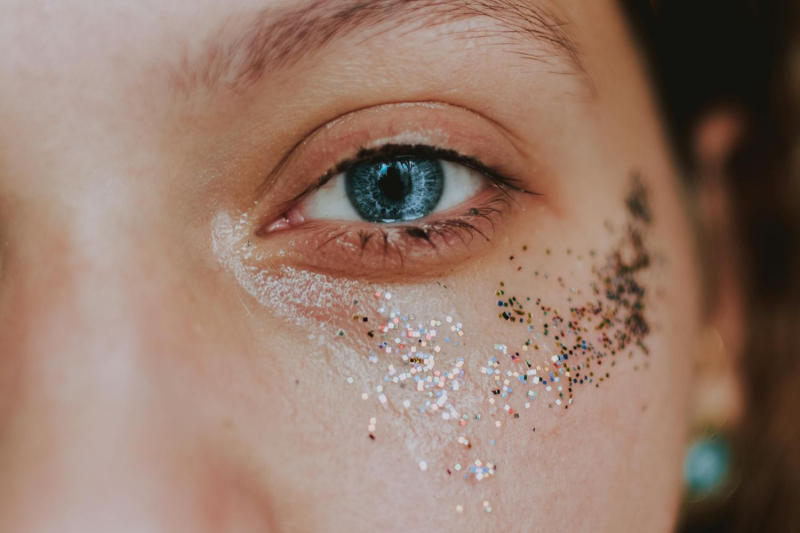
© lil artsy/Pexels
They are lovely, colorful and sparkling, but their shine is deceptive. A study published last year in the journal New Zealand Journal of Botanylifts the veil on a bleak reality regarding their environmental impact. Despite their relatively harmless appearance, they turn out to be a very significant source of pollution. These glistening microplastics pose a serious threat to aquatic ecosystems and their ability to regenerate. The European Commission has also banned their sale in October 2023.
A deleterious effect on aquatic ecosystems
The study in question, conducted by the Federal University of São Carlos (UFSCar) in Brazil, highlighted a new problem linked to the use of glitter. Although we already knew that they were found to be degraded in natural spaces and in the food chain, we did not know their impact on the good health of plants. Due to their composition, they reduce the penetration of sunlight into water and obstruct photosynthesis.
Indeed, composed mainly of Mylar (or BoPET, a polyester film) and covered with a thin metallic layer (iron, titanium, aluminum or bismuth), these microparticles strongly reflect light. This is why they are appreciated, but from an environmental point of view, it is a disaster.
By diverting light, they thus affect the vital ecological functions of certain macrophytes (aquatic plants) such as dense elodea ( Egeria densa), a plant found in South America.
According to Luana Lume Yoshida, master's student at UFSCar and lead author of the study, “these findings confirm the hypothesis that glitter interfere with photosynthesis, probably due to reflection of light from the metallic surface of the microplastic particles “.
In aquatic ecosystems, macrophytes play an essential role. They provide shelter, food, oxygen and shade to many other animal species. According to samples taken during the study's experiments, photosynthesis rates were 1.54 times higher in the absence of chaff. The harmful effect of these particles is indeed a reality.
Chain consequences on biodiversity
As written above, glitter also disrupt organisms globally, even those that do not require photosynthesis to survive. Marcela Bianchessi da Cunha-Santino, co-author of the study, explains: “ In this experiment, we specifically observed physical interference glitter on a species of macrophyte. However, the scientific literature is full of more well-known references regarding water contamination and the ingestion of these particles by other aquatic organisms “.
Indeed, glitter is found in many organisms present in ecosystems. Some animals may mistake them for food and ingest them. However, it is very difficult today to realize the extent of the problem. Indeed, research on the concentrations of flakes in water allows an exhaustive understanding of the phenomenon.
The data from this study are only an extrapolation of results from ;#8217;other experiments on microplastics. In reality, the problem may be even more serious than that.
Towards sustainable alternatives
If we think about it carefully, this problem goes beyond ecological considerations. Under the societal prime, it is symptomatic of an overdeveloped society, with almost self-destructive inclinations, pushing us to consider what is dispensable like essential. Sequins are just one example among many.
Rather than a clear disappearance of these little ornaments, the Researchers behind the study are calling for to reconsider their use. “ If more sustainable alternatives to glitter exist, why not switch to them now ? ,” asks Irineu Bianchini Jr., co-author of the study.
As is the case with many environmental issues, humans struggle to become aware of the facts, however serious they may be, s& #8217;they are not directly perceptible. In this specific case, the urgency of the question would become undeniable for most of us when we would be forced to separate the flakes from the bones in our plates of fish. As this is not yet the case, the problem seems distant to us.
Yet , disruption of the macrophyte photosynthesis process can lead to a real global disaster. These plants would produce less oxygen in the atmosphere and this would ultimately cause an increase in CO2 in the atmosphere. The biodiversity of marine ecosystems, which are among the most fragile in the world, would be seriously threatened and the potential consequences on food security and the economy would also be deleterious. We will survive the disappearance of glitter, but not that of macrophytes.
- A study published in the New Zealand Journal of Botany highlighted the negative effect of glitter on marine ecosystems.
- Due to their design, glitter obstructs the penetration of light into water and disrupt the photosynthesis of macrophytes.
- The consequences of this disturbance are serious, macrophytes playing an essential role in the balance of our planet.
📍 To not miss any news from Presse-citron, follow us on Google News and WhatsApp.
[ ]

